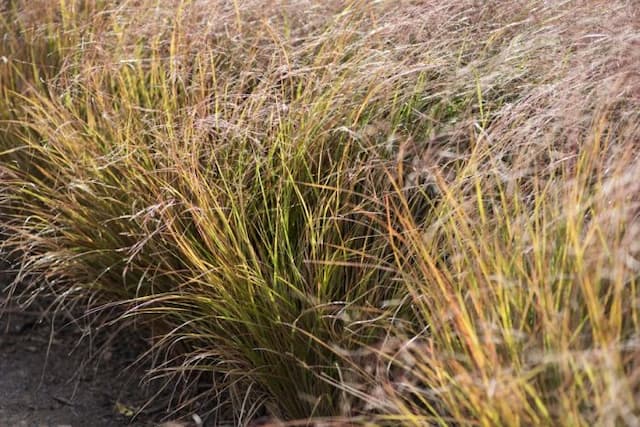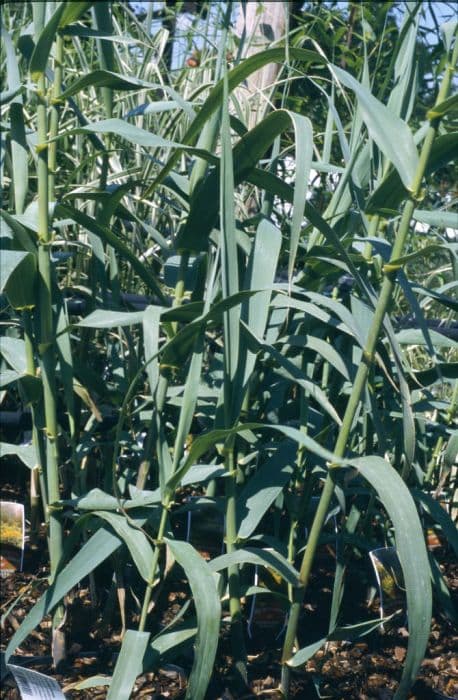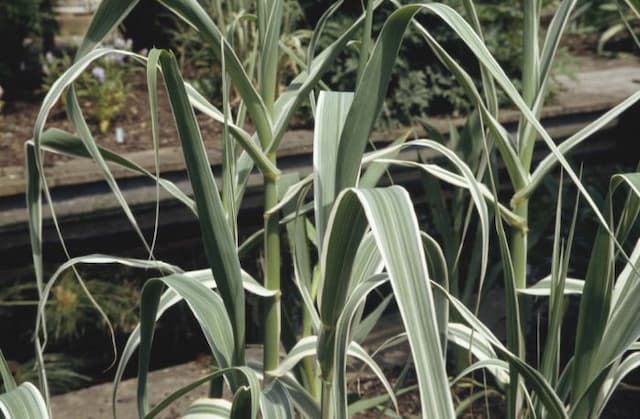Black bamboo Phyllostachys nigra











ABOUT
P. nigra is a large, elegant evergreen bamboo with arching canes, green at first becoming blackish-brown with maturity, and narrow-lanceolate leaves to 12cm in length
About this plant
 Names
NamesSynonyms
Black Bamboo, Black Phyllostachys, Black-Stemmed Bamboo.
Common names
Bambusa nigra, Phyllostachys nana, Phyllostachys quaesita, Sinarundinaria nigra, Arundarbor nigra.
 Characteristics
CharacteristicsLife cycle
Perennials
Foliage type
Evergreen
Color of leaves
Green
Height
20 feet [6 meters]
Spread
15 feet [4.5 meters]
Plant type
Bamboo
Hardiness zones
7
Native area
China
Benefits
 General Benefits
General Benefits- Aesthetic Appeal: Phyllostachys nigra, commonly known as black bamboo, adds a unique visual interest to landscapes with its striking black canes and lush green foliage.
- Privacy Screen: Due to its dense growth habit, black bamboo is often used as a natural privacy screen or hedge, providing seclusion without the need for fencing.
- Sound Barrier: The rustling of the bamboo leaves can create a soothing sound, which can help mask unwanted noise from traffic or neighbors, creating a more tranquil environment.
- Erosion Control: Black bamboo's root system can help to prevent soil erosion, particularly on slopes or areas prone to runoff.
- Windbreak: The dense clumps formed by this species of bamboo can serve as an effective windbreak, protecting other plants and reducing wind speed in open areas.
- Fast Growth: Black bamboo is known for its rapid growth rate, making it a quick solution for those wanting to establish a mature garden in a short amount of time.
- Sustainable Resource: Bamboo is a sustainable and renewable resource, offering an eco-friendly alternative for wood in furniture, flooring, and other products.
- Wildlife Habitat: Black bamboo provides habitat and food for a variety of wildlife, including birds and small mammals.
- Cultural Significance: In many cultures, black bamboo holds symbolic importance and is used in traditional arts, crafts, and construction, enriching cultural practices.
- Versatility: Black bamboo is used in a variety of applications from garden ornaments and structures to musical instruments, demonstrating its versatility as a material.
 Medical Properties
Medical Properties- Antipyretic: Black bamboo (Phyllostachys nigra) has been traditionally used to help reduce fever.
- Diuretic: It is also used to promote urine production and relieve water retention in some traditions.
- Detoxification: There are claims regarding its use in helping to eliminate toxins from the body.
- Anti-inflammatory: Some sources suggest that black bamboo may have anti-inflammatory effects.
 Air-purifying Qualities
Air-purifying QualitiesThis plant is not specifically known for air purifying qualities.
 Other Uses
Other Uses- Phyllostachys nigra, commonly known as Black Bamboo, has culms that can be polished and used to create ornamental objects or luxury crafts, either as standalone pieces or as part of a larger artwork.
- The shoots are edible and can be fermented to make bamboo shoot kimchi, a twist on the traditional Korean dish made with this plant's tender stems.
- Fine shavings from the Black Bamboo can be used as a natural filling for hypoallergenic pillows and mattresses, providing a sustainable alternative to synthetic materials.
- Its dense growth habit can be employed in landscape architecture for creating natural privacy screens or living fences in residential or urban spaces.
- When dried, this bamboo can be used to create musical instruments such as flutes or didgeridoos, taking advantage of the plant's hollow stems and natural resonance.
- The Black Bamboo is sometimes used as a dye plant; the dark color of its culms can be used to naturally stain fabrics and materials.
- Its durable canes can be crafted into long-lasting fishing rods by enthusiasts looking for bio-based gear, incorporating both beauty and function.
- In sustainable fashion, fibers derived from Black Bamboo can be spun to create eco-friendly textiles that are both soft and durable.
- The plant can be manipulated into living art by creatively shaping and directing its growth, commonly known as bamboo bonsai.
- Phyllostachys nigra's hard wood-like qualities allow it to be used for crafting cutting boards and kitchen utensils that are not only functional but also carry a unique aesthetic appeal.
Interesting Facts
 Feng Shui
Feng ShuiThe Black Bamboo is not used in Feng Shui practice.
 Plant Symbolism
Plant Symbolism- Mystique: Phyllostachys nigra, commonly known as Black Bamboo, bears a unique and striking appearance due to its dark-colored culms. It symbolizes the mysterious and the exotic, enticing onlookers with its distinctive look.
- Strength and Flexibility: As with most types of bamboo, Black Bamboo is known for its incredible strength and flexibility. These characteristics symbolize the ability to withstand life's challenges while being adaptable to change.
- Growth and Renewal: Bamboo plants are fast-growing, reflecting the ideas of rapid development and renewal. Black Bamboo, likewise, represents constant growth and the capacity for personal renewal.
- Purity and Innocence: Despite its dark coloration, bamboo is often associated with purity and innocence in various cultures, due to its simple and unpretentious form.
- Good Fortune: In many Asian cultures, bamboo is considered a symbol of good fortune or luck, and having Black Bamboo in your home or garden is thought to bring positive energy.
- Privacy: The dense growth pattern of Black Bamboo makes it an excellent natural screen, symbolizing the desire for privacy and creating personal sanctuaries.
 Water
WaterFor the Black Bamboo, it's crucial to maintain a consistent moisture level in the soil without overwatering. During the growing season, typically from spring to summer, water the plant deeply once a week, providing about 1 to 1.5 gallons per plant, adjusting based on weather conditions, ensuring the soil is moist but not soggy. In the winter, reduce watering to every other week or less, depending on rainfall and if the ground is frozen. Always check the top inch of soil for dryness before each watering to determine if additional moisture is needed. Overwatering can lead to root rot, so it is better to err on the side of too dry rather than too wet.
 Light
LightBlack Bamboo thrives in full sun to partial shade. It is adaptable but prefers a location that receives at least four hours of direct sunlight daily, with some afternoon shade in extremely hot climates. Avoid deep shade as it can result in reduced growth and thinner canes.
 Temperature
TemperatureBlack Bamboo grows best in temperate climates and can tolerate temperatures as low as 0 degrees Fahrenheit, although some leaf burn may occur. The maximum temperature it can withstand is around 100 degrees Fahrenheit, while the ideal temperature range for optimal growth is between 30 and 80 degrees Fahrenheit.
 Pruning
PruningPruning Black Bamboo is necessary to manage its spread, maintain its shape, and encourage new growth. Prune in the late winter or early spring before the growing season starts. Remove any dead, damaged, or overgrown canes at ground level using sharp, clean pruning shears. Thin out the clump by cutting some older canes to stimulate new, healthier shoots. It is often recommended to prune up to one-third of the plant each year for best results.
 Cleaning
CleaningAs needed
 Soil
SoilBlack Bamboo thrives in a well-draining soil mix with a slightly acidic to neutral pH between 6.0 and 7.0. A mixture of loam, sand, and compost is ideal to support its growth and provide proper drainage.
 Repotting
RepottingBlack Bamboo should be repotted every two to three years to accommodate its growth. However, it can quickly become root-bound, so monitoring its root system annually is advisable.
 Humidity & Misting
Humidity & MistingBlack Bamboo prefers moderate humidity levels but is adaptable to a range of conditions. It does well with standard outdoor humidity, while indoor plants may benefit from occasional misting.
 Suitable locations
Suitable locationsIndoor
Place Black Bamboo in a large container with ample light.
Outdoor
Grow in full sun to partial shade, provide space for spreading.
Hardiness zone
7-10 USDA
 Life cycle
Life cyclePhyllostachys nigra, commonly known as Black Bamboo, begins its life as a seed, germinating in the soil to produce a small seedling, which quickly establishes a root system. The seedling then grows into a young plant with characteristic lance-shaped leaves, and within a few months to a year, it begins developing rhizomes, which spread underground to create a clonal colony. After 2-5 years, the bamboo shoots rapidly from the rhizomes to reach its full height, with the culms turning from green to the distinctive black over a period of 1-3 years. Black Bamboo is a perennial plant, with individual culms living for around 10 years, but the clonal colony can persist for decades through continual production of new rhizomes and shoots. After maturing, the bamboo can flower, an event that is unpredictable and can occur anywhere from 60-120 years, after which the entire clone usually dies off. However, flowering is rare, and many bamboo stands never flower at all, instead propagating vegetatively through their rhizomes.
 Propogation
PropogationPropogation time
Spring-Early Summer
The most common name for Phyllostachys nigra is Black Bamboo. Regarding its propagation, the most popular method is through division, which is typically done in the spring just before the bamboo starts shooting. This involves carefully separating the rhizomes from a mature clump. One would dig around the parent plant to expose the rhizome with attached roots and shoots, ensuring there’s a good amount of roots for each division. Once separated, these rhizome sections can be potted up or planted immediately in another location. It's crucial that the transferred sections are kept moist and shaded until they establish in their new environment. The division should include at least a 6-inch length (about 15 cm) of rhizome to ensure a successful propagation.









